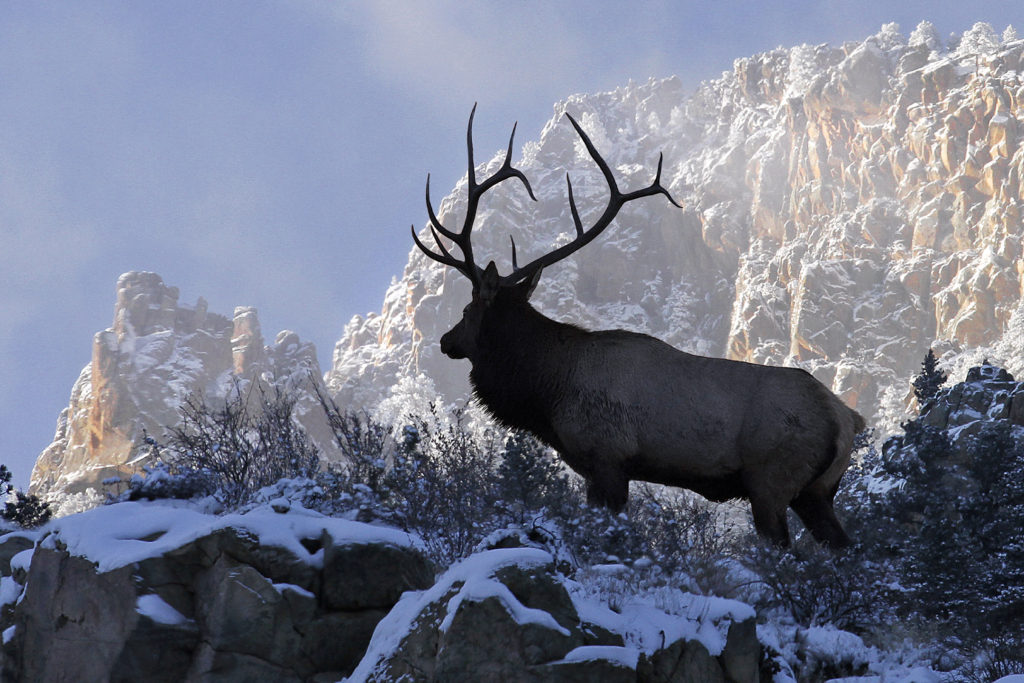Wisconsin’s Second Elk Season Yields Success for Lucky Hunters
Contact(s): Kevin Wallenfang, DNR deer and elk ecologist, 608-261-7589, Kevin.wallenfang@wisconsin.gov
November 20, 2019 at 11:45:01 am

Elk hunter Lydia Pernsteiner with the bull she harvested during Wisconsin’s second managed elk season.Photo credit: Photo Courtesy of Lydia Pernsteiner
MADISON, Wis. – Following more than 24 years of elk management and reintroduction efforts, five lucky hunters experienced success in the field during Wisconsin’s second managed elk hunt.
“Five bull-only tags were awarded again this year, and all five hunters were successful,” said Kevin Wallenfang, Deer and Elk Ecologist with the Wisconsin Department of Natural Resources. “Each one had the opportunity to share this once-in-a-lifetime experience with family and friends. One of the hunters had eight of his friends on hand to help get his bull out of the woods, and we had our first woman elk hunter this year. She got a great bull while her husband was right there to watch the hunt play out.”
Wallenfang said that all the hunters were excited about the overall experience and shared great stories of elk encounters. “It has been a positive, memorable experience for everyone,” Wallenfang said. “Other hunters they have bumped into were excited about the hunt, and folks from the local community were also beneficial to the elk hunters. Each hunter seems genuinely appreciative of the opportunity, and I think a few still cannot believe it happened to them.”
In addition to the five bulls harvested by state hunters, members of the Ojibwa tribes successfully filled their five-bull quota. The tribes receive up to half of the overall elk harvest quota annually.
The area where elk hunting is allowed falls within the Clam Lake elk range of Sawyer, Bayfield, Ashland and Price counties where 25 elk from Michigan were released in 1995. The hunt was initiated last year when the original population surpassed 200 animals. The Clam Lake population is currently approximately 275 elk. Elk hunting was not allowed in areas where elk were reintroduced from Kentucky in recent years.
Wallenfang indicated that each of the bulls harvested by state hunters varied in size, but all had impressive antlers. The majority were mature bulls, and hunters routinely reported seeing several bulls and multiple opportunities.
Last year, nine out of the 10-bull quota were filled by state and tribal hunters in the historic first year of state-managed elk hunting in Wisconsin.
Over 23,000 Wisconsin residents submitted a $10 application in 2019 to win one of four state tags, and approximately 2,500 more purchased a raffle ticket to win the final tag from a Rocky Mountain Elk Foundation drawing. Seven dollars from each application and all raffle proceeds are earmarked specifically for elk management in Wisconsin. The 2020 elk hunt application period is anticipated to start with the new license year on March 1 and run through May 31.
For more information regarding elk in Wisconsin, visit the DNR Website. To receive email updates regarding current translocation efforts, visit the DNR Website and click on the email icon near the bottom of the page titled “subscribe for updates for DNR topics,” then follow the prompts and select the “elk in Wisconsin” and “wildlife projects” distribution lists.
